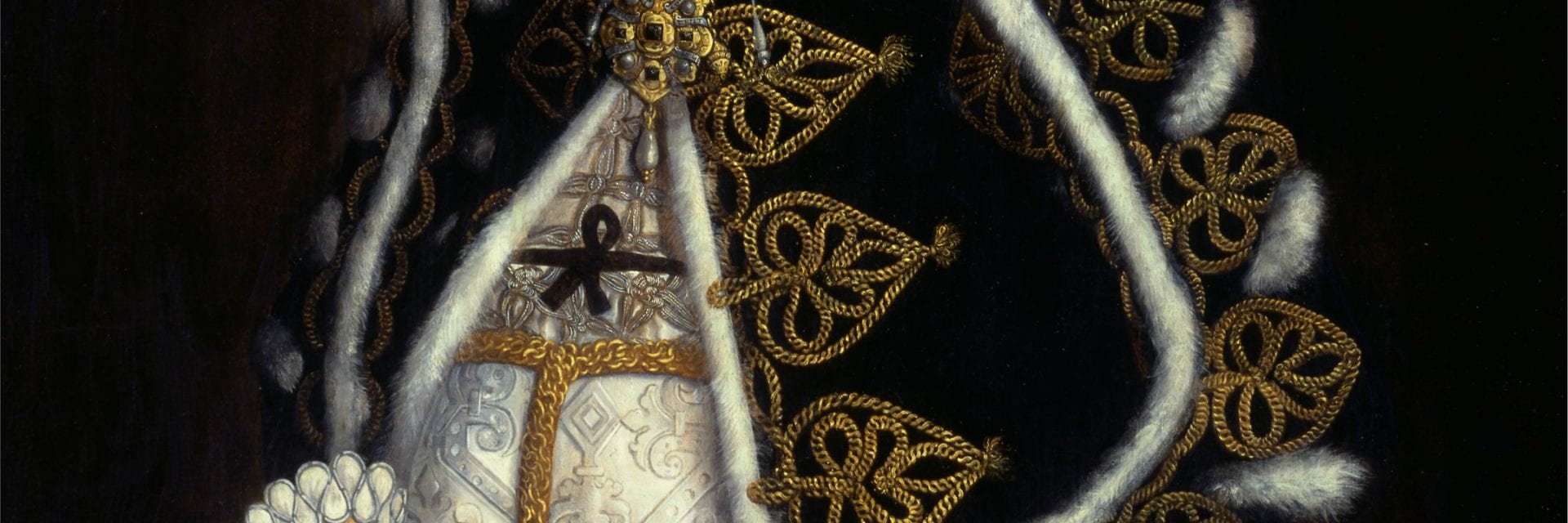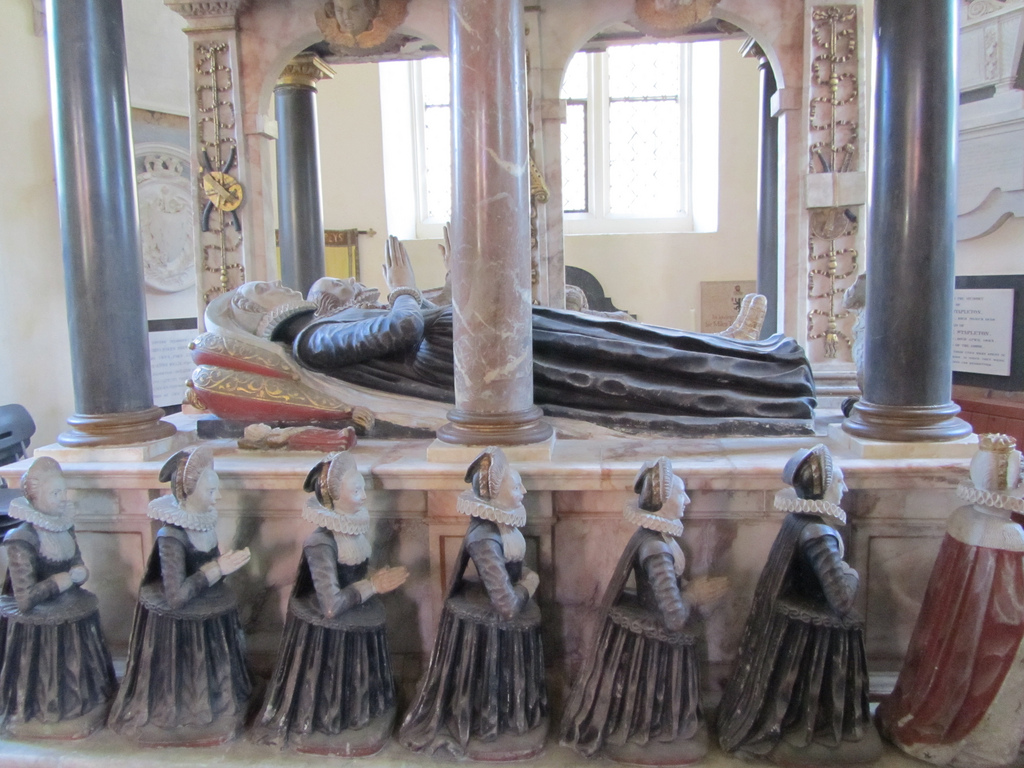

Does this good gentlewoman, Lady Katherine Knollys, remind you of anyone? Her mother was Mary Boleyn and her father William Carey – or was he?
Mary and Anne Boleyn were the daughters of the ambitious and greedy but loyal Tudor supporter Thomas Boleyn, Earl of Wiltshire & Ormond. Thomas served as Esquire of the King’s Body along with many other prestigious and lucrative appointments, combining the role of ambassador, friend and royal entertainer – perhaps he overstretched himself just a tad.
Thomas’ two daughters both famously caught the eye of the King. The rise and fall of Anne is well documented, that of Mary, until recently less so, perhaps because her exit from the Royal scene was less dramatic.
There is no denying that Henry VIII was, how shall I put it, amorous, but it may come as some surprise to know that he was also extremely discreet when it came to his love affairs. This factor makes it difficult for historians to pin down exactly the date of his affair with Mary Boleyn, which has implications for establishing whether Katherine Carey was his bastard daughter or not.
Numerous eminent historians have taken a stab as to when Henry’s affair with Mary began and ended. One has suggested it began as early as 1515 and another that it didn’t end until 1525, but the general consensus seems to be that the affair began after Mary’s marriage to William Carey in February 1520 and lasted, most probably, between 1522 and 1524. It was also generally thought that of Mary’s two children Henry was the elder and Katherine the younger, but opinion has changed there too, mainly to the discovery of a dictionary belonging to Sir Francis Knollys, but I I’ll come to that later.
Henry was unlikely to acknowledge Mary’s children as his own for one very important reason. To confess to an affair with her sister would complicate his marriage to Anne and his divorce proceedings with Katherine under the consanguinity laws.
In her book Mary Boleyn, Alison Weir states that any evidence to Katherine Carey being Henry’s daughter is ‘circumstantial and inferential’ and that ‘positive proof is lacking,’ but when all is said and done there are some tantalizing indicators.
Katherine was born in 1524 and just a couple of months after her birth a grant was made to William Carey which has been seen by some as a reward for being not only a compliant husband but for raising a royal bastard.
After William Carey’s death in 1528, Mary and her two young children returned to the Boleyn family home at Hever Castle. In December of that same year Henry assigned Mary an annuity of £100 worth somewhere in the region of £32,000 today. Was this to make provision for Katherine?
On September 7, 1533 Anne gave birth to a daughter. Alison Weir writes:
“It is possible that Katherine Carey, who was nine when the Princess Elizabeth was born, spent the next six years, until she was summoned to court, in her little cousin’s household, which was set up at Hatfield Palace, Hertfordshire.”
The two women were extremely close throughout their lives with Katherine known at court as the ‘kinswoman and good servant’ of the Queen on whom she served in constant attendance, from 1558 until her death in 1569.
And then there is the portrait …
Painted by Steven van der Meulan in 1562, the portrait shows a heavily pregnant Katherine Knollys described as being in her 38th year, which ties her birth to 1524 and fits in nicely with everything else we know.
She bears a striking resemblance to Henry VIII and also to his mother Elizabeth of York. Alison Weir points out that she has the same heavy lower eyelids and winged eyebrows and also the prominent chin and rounded jowls – and, of course that Tudor red hair (Mary’s hair colour is unknown and William Carey’s hair was brown)
On April 26, 1540 Katherine married Sir Francis Knollys, a Gentleman Pensioner in the King’s household – he was 26 years old, she was 16. A year later the first of at least 14 (most probably 16) babies was born.
It is difficult to pin down the couple’s whereabouts during the first years of their marriage.They may have lived at court or as members of Elizabeth’s household. Lettice, their third child, was born in 1543 at the family seat of Rotherfield Greys, Oxfordshire and it is more than likely some of their other children were born there too.
Protestant Sir Francis fled the country for Geneva in 1553 when Catholic Mary acceded to the throne and the Knollys couple lived apart for a couple of years, revealing a gap in the number of babies born to them.
When Katherine left court to join him, Elizabeth wrote her the following letter, signed Cor Rotto – broken hearted.
‘Relieve your sorrow for your far journey with joy of your short return and think this pilgrimage rather a proof of your friends than a leaving of your country. The lengthof time and distance of place separates not the love of friends nor deprives not the shew of goodwill. An old saying, when bale is lowest, boot is nearest,’ when your need shall be most, you shall find my friendship greaterest. Let other promise and I will do, in words not mo, in deeds as much. My power but small, my love as great as they whose gifts may tell their friendships’ tale. Let will supply all other want, and oft sending take the lieu of often sights. Your messengers shall not return empty nor yet your desires unaccomplished. Lethe’s flood hath here no course, good memory hath greatest stream, and to conclude – a word that hardly I can say, I am driven by need to write – farewell it is, which, in the sense one way I wish, the other way I grieve.
Your loving cousin and ready friend,
Cor rotto
Francis and Katherine spent sometime in Basel and Strasbourg and in 1557 they were living in Frankfurt Am Main with five of their children.
The couple returned to England upon Elizabeth’s accession to the throne in 1558 and both Katherine and Francis continued in the Queen’s service. On January 3, 1559 Katherine was made Chief Lady of the Privy Chamber.
Occupying an influential position at court, Francis is recorded as being of a sombre character, committed to religious reform while Katherine was intelligent and known for the straightforward advice she gave to those who sought her opinion, including her cousin the Queen.
In 1565 Katherine became Chief Lady of the Bedchamber. Three years later Sir Francis was appointed guardian of Mary, Queen of Scots whom Elizabeth placed under arrest in Bolton Castle.
A combination of more than twenty years of childbearing and long hours in the Queen’s service saw Katherine’s health compromised and in 1568 she fell ill with fever. Sir Francis was refused permission to return to visit her, and when she rallied slightly and asked Elizabeth if she might travel to see her husband, this was also refused.
She died at Hampton Court on January 15, 1569, with the Queen in attendance in a reversal of roles.Elizabeth was inconsolable for many months.
Katherine’s funeral took place in April 1569 in St Edmund’s Chapel in Westminster Abbey. Elizabeth had overseen the arrangements and paid the bill, an astronomical £640 2s 11d (more than £111,000 by today’s values).
Katherine was buried beneath the floor in the Chapel of St Edmund, Westminster Abbey and a plaque carries the following inscription:
“The Right Honorable Lady Katherin Knollys Cheeffe Lady of the Quenes Maties [Majesty’s] Beddechamber and wiffe to Sr. Frances Knollys Knight Tresorer [Treasurer] of her Highnes Howsholde. Departed this lyefe the 15. of January 1568. At Hampton Courte. And was honorably buried in the flower [floor] of this chappell. This Lady Knollys and the Lord Hundesdon her brother were the childeren of William Caree Esquyer, and of the Lady Mary his wiffe one of the doughters and heires to Thomas Bulleyne Erle of Wylshier [Wiltshire] and Ormond. Which Lady Mary was sister to Anne Quene of England wiffe to Kinge Henry the Eyght father and mother to Elizabeth Quene of England”.
Katherine’s date of death is recorded in the Old Style when Lady Day (March 25) marked the beginning of the New Year.
A Latin inscription below this is translated as follows:
“O, Francis, she who was thy wife, behold, Catherine Knolle lies dead under the chilly marble. I know well that she will never depart from thy soul, though dead. Whilst alive she was always loved by thee: living, she bore thee, her husband, sixteen children and was equally female and male (that is, both gentle and valiant). Would that she had lived many years with thee and thy wife was now an old lady. But God desired it not. But he willed that thou, O Catherine, should await thy husband in Heaven”.
In 2006 Sally Varlow wrote a paper about the discovery of a Latin dictionary that had belonged to Sir Francis Knollys’s and in which he had recorded the date of his marriage and the names and birthdates of fourteen children born to his wife Katherine, thereby helping to establish in turn the date of her own birth.
In 1605 Francis and Katherine’s second son and heir, William, erected a magnificent monument to his parents in the church of St Nicholas, Rotherfield Greys, near the family home Greys Court outside Henley on Thames. The monument includes seven female ‘weepers’ on one side of the memorial and seven male ‘weepers’ on the other, with a swaddled baby lying next to Katherine, presumably Dudley, the baby she is pregnant with in the van der Meulan portrait painted in 1562 and who died in infancy.

The Knollys monument at Rotherfield Greys
The procession of female figures is headed by Lettice Knollys who, although not the eldest daughter, married two Earls (Essex and Leicester) and therefore outranked her sisters. Historian Sally Varlow suggests that William’s wife Dorothy might also be included in the line up, which spoils my plan. Even allowing for Lettice jumping the queue, Elizabeth, born in 1549, would still be the fourth woman in the procession.
Could this be the face of Elizabeth Knollys and if so, why should she be of interest to the readers of Good Gentlewoman.
Elizabeth Knollys married Sir Thomas Leighton and had three surviving children. A son Thomas and two daughters Elizabeth and Anne.
Anne Leighton would go on to marry John St John, 1st Baronet and have her own large family. She is represented on the St John polyptych in St Mary’s Church and on the Bedstead tomb lying next to her husband and his second wife Margaret Whitmore, Lady Grobham. She died following the birth of her 13th child, a son Henry who survived her.
Now have a look at the portrait of Anne Leighton, that hangs in the dining room at Lydiard House and tell me, does she remind you of anyone?
Mary Boleyn by Alison Weir